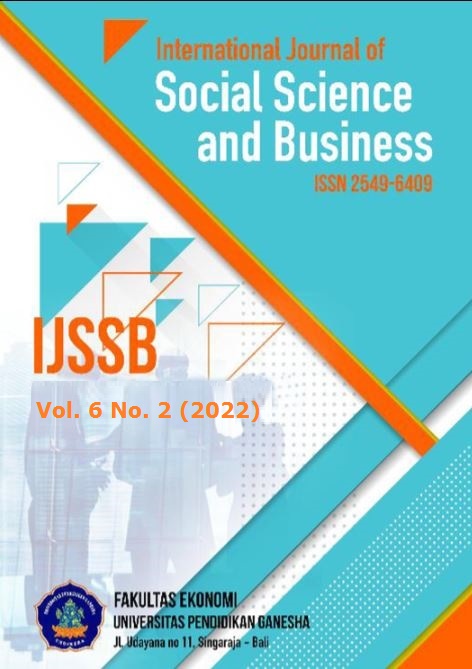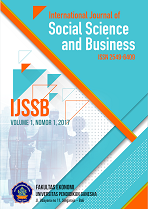Diamond Fraud Analysis in Detecting Financial Statement Fraud in Manufacturing Companies
DOI:
https://doi.org/10.23887/ijssb.v6i2.46369Keywords:
Fraud, Financial statements, Manufacturing companiesAbstract
Business people must provide accurate and relevant information and be free from fraud that will mislead other parties. To provide appropriate information for users of financial statements, the preparation of these financial statements must be prepared as well as possible according to accurate data based on applicable accounting rules. This study aims to analyze the effect of financial stability, external pressure, industry nature, rationalization, and capability on financial statement fraud. This study uses secondary data. The design used in this research is causal research. The research population was conducted on all manufacturing companies that went public and were active on the Indonesia Stock Exchange (IDX) during the 2015-2019 period. The sampling technique used the purposive sampling method. According to the sampling criteria, a total sample of 63 companies was obtained from the observations in this study. The results of this study prove that financial stability and rationalization affect financial statement fraud. Meanwhile, external pressure, the nature of the industry, and the capability do not affect fraudulent financial statements.
References
Alifatussalimah, & Sujud, A. (2020). Pengaruh ROA, NPM, DER, Dan EPS Terhadap Harga Saham Perusahaan Subsektor Perkebunan Di Bursa Efek Indonesia. Oikonomia: Jurnal Management, 16(2). https://doi.org/10.47313/oikonomia.v16i2.1142. DOI: https://doi.org/10.36085/jakta.v1i2.1130
Ananda, R. P., Ilona, D., & Rahma, A. A. (2021). The Influence of Ethnic, Gender, and Qualification of Directors on Company Performance. UPI YPTK Journal of Business and Economics, 6(2), 15–20. https://doi.org/10.35134/jbe.v6i2.17. DOI: https://doi.org/10.35134/jbe.v6i2.17
Asih, P. N. W., & Sunaryanto, S. (2022). Determinan Academic Dishonesty Behaviour Mahasiswa Akuntansi Dalam Online Exams: Perspektif Fraud Pentagon Dan Test Anxiety. Jurnal Akademi Akuntansi, 5(2), 236–255. https://doi.org/10.22219/jaa.v5i2.20156.
Badamchi, K., & Showkati, H. (2022). Experiments on buckling behavior of thin-walled steel pipes subjected to axial compression and external pressure. Thin-Walled Structures, 74. https://doi.org/10.1016/j.tws.2022.109122. DOI: https://doi.org/10.1016/j.tws.2022.109122
Biswas, P. K., Habib, A., & Ranasinghe, D. (2022). Firm life cycle and financial statement comparability. Advances in Accounting, 58. https://doi.org/10.1016/j.adiac.2022.100608. DOI: https://doi.org/10.1016/j.adiac.2022.100608
Bramasto, A. (2011). Analisis Perputaran Aktiva Tetap dan Perputaran Piutang Kaitannya Terhadap Return On Assets Pada PT. POS Indonesia (PERSERO) Bandung. Majalah Ilmiah UNIKOM.
Cao, S., Wang, J., & Zhou, J. (2022). Pricing like things alike: The role of financial statement comparability in bond pricing. International Review of Economics & Finance, 79. https://doi.org/10.1016/j.iref.2022.02.059. DOI: https://doi.org/10.1016/j.iref.2022.02.059
Chaubey, A., & Sahoo, C. K. (2021). Assimilation of business intelligence: The effect of external pressures and top leaders commitment during pandemic crisis. International Journal of Information Management, 59. https://doi.org/10.1016/j.ijinfomgt.2021.102344. DOI: https://doi.org/10.1016/j.ijinfomgt.2021.102344
Cheng, C.-H., Kao, Y.-F., & Lin, H.-P. (2021). A financial statement fraud model based on synthesized attribute selection and a dataset with missing values and imbalanced classes. Applied Soft Computing, 108. https://doi.org/10.1016/j.asoc.2021.107487. DOI: https://doi.org/10.1016/j.asoc.2021.107487
Durocher, S., & Fortin, A. (2021). Financial statement users’ institutional logic. Journal of Accounting and Public Policy, 40(2). https://doi.org/10.1016/j.jaccpubpol.2021.106819. DOI: https://doi.org/10.1016/j.jaccpubpol.2021.106819
Faradiza, S. A. (2019). Fraud pentagon dan kecurangan laporan keuangan. EkBis: Jurnal Ekonomi Dan Bisnis, 2(1), 1–22. https://doi.org/10.14421/EkBis.2018.2.1.1060. DOI: https://doi.org/10.14421/EkBis.2018.2.1.1060
Hamdani, R., & Albar, A. R. (2016). Internal controls in fraud prevention effort: A case study. Jurnal Akuntansi dan Auditing Indonesia, 20(2), 127. https://doi.org/10.20885/jaai.vol20.iss2.art5. DOI: https://doi.org/10.20885/jaai.vol20.iss2.art5
Hardiwinoto, S., Nurjanto, H. H., Nugroho, A. W., & Widiyatno, W. (2011). Pengaruh Komposisi Dan Bahan Media Terhadap Pertumbuhan Semai Pinus (Pinus merkusii). Hutan Tanaman, 8(1). https://doi.org/10.20886/jpht.2011.8.1.9-18. DOI: https://doi.org/10.20886/jpht.2011.8.1.9-18
Herman, L. A. (2013). Pengaruh keadilan organisasi dan sistem pengendalian intern terhadap kecurangan (studi empiris pada kantor cabang utama bank pemerintah di Kota Padang). Jurnal Akuntansi, 1(1).
Huang, G. (2006). The determinants of capital structure: Evidence from China. China economic review, 17(1), 14–36. https://doi.org/10.1016/j.chieco.2005.02.007. DOI: https://doi.org/10.1016/j.chieco.2005.02.007
Huda, M. (2014). Model Manajemen Fundraising Wakaf. Ahkam: Jurnal Ilmu Syariah, 13(1). https://doi.org/10.15408/ajis.v13i1.948. DOI: https://doi.org/10.15408/ajis.v13i1.948
Kamaluddin, N., & Haryati, M. A. (2020). Evaluasi Sistem Pengendalian Intern Terhadap Pemberian Kredit Bumdes Bangun Bersama. Monex: Journal Research Accounting Politeknik Tegal, 9(1). https://doi.org/10.30591/monex.v9i1.1772.
Kayoi, S. A., & Fuad, F. (2019). Faktor-Faktor Yang Mempengaruhi Financial Statement Fraud Ditinjau Dari Fraud Triangle Pada Perusahaan Manufaktur Di Bursa Efek Indonesia Periode 2015-2017. Diponegoro Journal Of Accounting, 8(4).
Khan, H. H. (2022). Bank competition, financial development and macroeconomic stability: Empirical evidence from emerging economies. Economic Systems. https://doi.org/10.1016/j.ecosys.2022.101022. DOI: https://doi.org/10.1016/j.ecosys.2022.101022
Lenssen, G., Blagov, Y., Bevan, D., Cui, Y., & Jiao, H. (2011). Dynamic capabilities, strategic stakeholder alliances and sustainable competitive advantage: evidence from China. Corporate Governance: The international journal of business in society. https://doi.org/10.1108/14720701111159235. DOI: https://doi.org/10.1108/14720701111159235
Listyaningrum, D., Paramita, P. D., & Oemar, A. (2017). Pengaruh Financial Stability, External Pressure, Financial Target, Ineffective Monitoring Dan Rasionalisasi Terhadap Kecurangan Pelaporan Keuangan (Fraud) Pada Perusahaan Manufaktur Di Bei Tahun 2012-2015. Journal Of Accounting, 3(3).
Maghfiroh, N., Ardiyani, K., & Syafnita, S. (2015). Analisis pengaruh financial stability, personal financial need, external pressure, dan ineffective monitoring pada financial statement fraud dalam perspektif fraud. Jurnal Ekonomi dan bisnis, 16(1). https://doi.org/10.31941/jebi.v16i1.321.
Moraes, C. O. de, & Costa, Á. (2022). Credit behavior and Financial Stability in an Emerging Economy. Economic Systems. https://doi.org/10.1016/j.ecosys.2022.100999. DOI: https://doi.org/10.1016/j.ecosys.2022.100999
Myers, J. N., Myers, L. A., & Skinner, D. J. (2007). Earnings momentum and earnings management. Journal of Accounting, Auditing & Finance, 22(2), 249–284. https://doi.org/10.1177/0148558X0702200211. DOI: https://doi.org/10.1177/0148558X0702200211
Novitasari, A. R., & Chariri, A. (2019). Analisis Faktor-Faktor yang Mempengaruhi Financial Statement Fraud dalam Perspektif Fraud Pentagon. Diponegoro Journal of Accounting, 7(4). DOI: https://doi.org/10.29040/jap.v20i2.618
Nugraheni, N. K., & Triatmoko, H. (2017). Analisis faktor-faktor yang mempengaruhi terjadinya financial statement fraud: perspektif diamond fraud theory (Studi pada perusahaan perbankan yang terdaftar di Bursa Efek Indonesia Periode 2014-2016). Jurnal Akuntansi dan Auditing, 14(2), 118–143. https://doi.org/10.14710/jaa.14.2.118-143. DOI: https://doi.org/10.14710/jaa.14.2.118-143
Nugroho, H. (2017). Analisis Financial Statement Fraud Dalam Perspektif Triangle Fraud Pada Perbankan Yang Terdaftar Di Bursa Efek Indonesia Periode 2010-2014. GEMA: Jurnal Gentiaras Manajemen dan Akuntansi, 9(1), 1–9. DOI: https://doi.org/10.21460/jrak.2015.111.247
Nurbaiti, Z., & Hanafi, R. (2017). Analisis Pengaruh Fraud Diamond Dalam Mendeteksi Tingkat Accounting Irregularities. Jurnal Akuntansi Indonesia, 6(2), 167–184. https://doi.org/10.30659/jai.6.2.167-184. DOI: https://doi.org/10.30659/jai.6.2.167-184
Ochiai, T., & Nacher, J. C. (2022). Unveiling the directional network behind financial statements data using volatility constraint correlation. Physica A: Statistical Mechanics and its Applications, 600. https://doi.org/10.1016/j.physa.2022.127534. DOI: https://doi.org/10.1016/j.physa.2022.127534
Pasaribu, R. B. F., & Kharisma, A. (2018). Fraud Laporan Keuangan Dalam Perspektif Fraud Triangle. Jurnal Riset Akuntansi & Keuangan, 14(1), 53–65. https://doi.org/10.21460/jrak.2018.141.299. DOI: https://doi.org/10.21460/jrak.2018.141.299
Pramudita, A. (2013). Analisis Fraud di Sektor Pemerintahan Kota Salatiga. Accounting Analysis Journal, 2(1). https://doi.org/10.15294/aaj.v2i1.1156.
Priantinah, D. (2009). Manajemen Laba Ditinjau Dari Sudut Pandang Oportunistik dan Efisien Dalam Positive Accounting Theory. Jurnal Pendidikan Akuntansi Indonesia, 8(1). https://doi.org/10.21831/jpai.v8i1.948. DOI: https://doi.org/10.21831/jpai.v8i1.948
Puspitaningrum, W. P. (2014). Pendeteksian Kecurangan Laporan Keuangan Pemerintah Daerah di Indonesia (Studi Kasus pada Pemerintah Kota Surakarta). Jurnal Akuntansi dan Bisnis, 14(1). https://doi.org/10.20961/jab.v14i1.153. DOI: https://doi.org/10.20961/jab.v14i1.153
Putri, I. A. S., & Suprasto, B. (2016). Pengaruh Tanggung Jawab Sosial Perusahaan dan Mekanisme Tata Kelola Perusahaan Terhadap Nilai Perusahaan. E-Jurnal Akuntansi, 15(1), 667–694.
Putriasih, K., Herawati, N. T., AK, S., & Wahyuni, M. A. (2016). Analisis fraud diamond dalam mendeteksi financial statement fraud: Studi empiris pada perusahaan manufaktur yang terdaftar di Bursa Efek Indonesia (BEI) tahun 2013-2015. JIMAT (Jurnal Ilmiah Mahasiswa Akuntansi) Undiksha, 6(3). https://doi.org/10.23887/jimat.v6i3.8808.
Rachmania, A., Slamet, B., & Iryani, L. D. (2017). Analisis pengaruh fraud triangle terhadap kecurangan laporan keuangan pada perusahaan makanan dan minuman yang terdaftar di Bursa Efek Indonesia periode 2013-2015. Jurnal Online Mahasiswa (JOM) Bidang Akuntansi, 4(2).
Rahma, A. A., Lusiana, L., & Indriani, P. (2019). Pengaruh Struktur Modal, Profitabilitas dan Size Perusahaan Terhadap Ketepatan Waktu Pelaporan Keuangan Pada Perusahaan Manufaktur. Jurnal Benefita, 4(2), 210–220. https://doi.org/10.22216/jbe.v4i2.3698. DOI: https://doi.org/10.22216/jbe.v4i2.3698
Rahmayani, A. (2019). Pengaruh Model Pembelajaran Discovery Learning dengan Menggunakan Mediavideo Terhadap Hasil Belajar. Jurnal Pendidikan Teori dan Praktek, 4(1). https://doi.org/10.26740/jp.v4n1.p59-62. DOI: https://doi.org/10.26740/jp.v4n1.p59-62
Riswandi, P., & Yuniarti, R. (2020). Pengaruh Manajemen Laba Terhadap Nilai Perusahaan. Jurnal Pamator: Jurnal Ilmiah Universitas Trunojoyo, 13(1), 134–138. https://doi.org/10.21107/pamator.v13i1.6953. DOI: https://doi.org/10.21107/pamator.v13i1.6953
Ruankaew, T. (2016). Beyond the fraud diamond. International Journal of Business Management and Economic Research (IJBMER), 7(1), 474–476.
Rustiarini, N. W., Sutrisno, T., Nurkholis, N., & Andayani, W. (2019). Why people commit public procurement fraud? The fraud diamond view. Journal of public procuremen, 19(4), 345–362. https://doi.org/10.1108/JOPP-02-2019-0012. DOI: https://doi.org/10.1108/JOPP-02-2019-0012
Saerang, I., Tommy, P., & Christiano, M. (2014). Analisis Terhadap Rasio-rasio Keuangan Untuk Mengukur Profitabilitas Pada Bank-bank Swasta Yang Go Public Di Bursa Efek Indonesia. Jurnal Riset Ekonomi, Manajemen, Bisnis dan Akuntansi, 2(4), 817–830. https://doi.org/10.35794/emba.v2i4.6490.
Saputra, N., Sasanti, N., Alamsjah, F., & Sadeli, F. (2022). Strategic role of digital capability on business agility during COVID-19 era. Procedia Computer Science, 197. https://doi.org/10.1016/j.procs.2021.12.147. DOI: https://doi.org/10.1016/j.procs.2021.12.147
Sari, D. H., Khairiyah, N. M., & Ismawanto, T. (2021). Efektivitas Pelaksanaan Restrukturisasi Kredit Sebagai Strategi Penurunan Kredit Bermasalah Selama Pandemic Covid-19 Pegadaian Kanwil Balikpapan. Jurnal Studi Management dan Bisnis, 8(2). https://doi.org/10.21107/jsmb.v8i2.12589. DOI: https://doi.org/10.21107/jsmb.v8i2.12589
Satria, M. R., & Fatmawati, A. P. (2021). Penyusunan Laporan Keuangan Perusahaan Menggunakan Aplikasi Spreadsheet (Pada Pd Beras Padaringan). Fair Value Jurnal Ilmiah Akuntansi Dan Keuangan, 3(2), 146–164. https://doi.org/10.32670/fairvalue.v3i2.146. DOI: https://doi.org/10.32670/fairvalue.v3i2.146
Septriani, Y., & Handayani, D. (2018). Mendeteksi kecurangan laporan keuangan dengan analisis fraud pentagon. Jurnal Akuntansi Keuangan Dan Bisnis, 11(1), 11–23.
Shen, Y., Guo, C., Li, H., Chen, J., Guo, Y., & Qiu, X. (2021). Financial Feature Embedding with Knowledge Representation Learning for Financial Statement Fraud Detection. Procedia Computer Science, 187. https://doi.org/10.1016/j.procs.2021.04.110. DOI: https://doi.org/10.1016/j.procs.2021.04.110
Stuebs, M., Bryant, S. M., Edison, C., & Stanley, C. (2022). Brittney’s Boutique: Tailoring financial statements for function as well as fashion. Journal of Accounting Education, 58. DOI: https://doi.org/10.1016/j.jaccedu.2022.100768
Suryani, I. C. (2019). Analisis Fraud Diamond Dalam Mendeteksi Financial Statement Fraud: Studi Empiris Pada Perusahaan Manufaktur Yang Terdaftar Di Bursa Efek Indonesia (Bei) Tahun 2016–2018. Prosiding Seminar Nasional Cendekiawan, 2–12. DOI: https://doi.org/10.25105/semnas.v0i0.5780
Triangle, P. F. (2015). Analisis Determinan Financial Statement Melalui Pendekatan Fraud Triangle. Accounting Analysis Journal, 4(1), 1–10. https://doi.org/10.15294/aaj.v4i1.7761.
Utami, A. L., Sumarno, M., & Fanani, B. (2017). Pengaruh Fraud Triangle terhadap Deteksi Kecurangan Laporan Keuangan pada Perusahaan Perbankan yang Terdaftar di Bursa Efek Indonesia Tahun periode 2014-2017. Permana: Jurnal Perpajakan, Manajemen, dan Akuntansi, 9(1). DOI: https://doi.org/10.31000/competitive.v1i1.106
Wang, Y., Yu, M., & Gao, S. (2022). Gender diversity and financial statement fraud. Journal of Accounting and Public Policy, 41(2). https://doi.org/10.1016/j.jaccpubpol.2021.106903. DOI: https://doi.org/10.1016/j.jaccpubpol.2021.106903
Yesiariani, M., & Rahayu, I. (2017). Deteksi financial statement fraud: Pengujian dengan fraud diamond. Jurnal Akuntansi dan Auditing Indonesia, 21(1), 49. https://doi.org/10.20885/jaai.vol21.iss1.art5. DOI: https://doi.org/10.20885/jaai.vol21.iss1.art5
Zhang, Y., Hu, A., Wang, J., & Zhang, Y. (2022). Detection of fraud statement based on word vector: Evidence from financial companies in China. Finance Research Letters, 46. https://doi.org/10.1016/j.frl.2021.102477. DOI: https://doi.org/10.1016/j.frl.2021.102477
Downloads
Published
How to Cite
Issue
Section
License
Copyright (c) 2022 Anita Ade Rahma, Winda Afriyenis, Khalida Syiah Rangkuti

This work is licensed under a Creative Commons Attribution-ShareAlike 4.0 International License.











